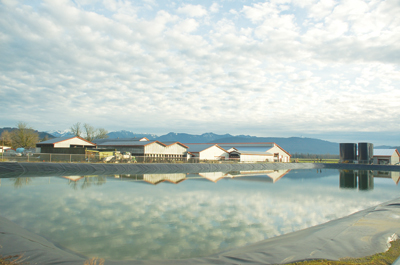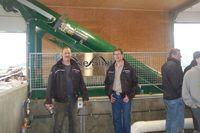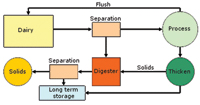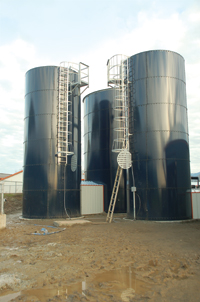
News
Switch to sand
New manure management system ‘best thing’ for B.C. dairy
May 13, 2011 by David Schmidt
One thing leads to another.
Necessity is the mother of invention.
Those old adages are certainly true at Baarsview Farms in Deroche, B.C.

|
| Baarsview’s lagoon has a polyethylene seam-welded liner. The Baarses intend to spread the liquid on their land using a dragline to minimize odor. Advertisement
|
One thing leads to another.
Necessity is the mother of invention.
Those old adages are certainly true at Baarsview Farms in Deroche, B.C.
When Gerard and Harm Baars decided to build a new barn to house their 130-cow milking herd, their vet recommended they switch to sand instead of sawdust bedding for the health benefits it would provide.
Enter the adage, “one thing leads to another,” as that decision ultimately led to installation of Canada’s first DariTech Biolynk system with a One-Shot sand separator. Developed just across the border by DariTech Inc. of Lynden, Wash., the sand separator and Biolynk system are the result of the second adage – necessity is the mother of invention.
After agreeing to use sand, the Baars brothers decided to use a flush system instead of alley scrapers to clean out the barn.

|
|
| Gerard and Harm Baars of Baarsview Farms, shown here standing in front of their farm’s new One-Shot sand separator, decided to switch to sand bedding from sawdust after building a new barn to house their 130-cow milking herd.
|
“The sand would cause too much wear and tear on mechanical scrapers,” Gerard explains.
However, flush systems have two drawbacks: a need to filter the sand out of the waste stream and increased odor from the recycled liquid. The Biolynk system and sand separator are intended to resolve both those issues.
The One-Shot Sand Separator is a new product, the Baarsview installation being only the second in North America. It eliminates the large settling ponds that most farms using sand bedding put in to remove sand from the manure.
It also has more horsepower than the only other mechanical sand separator made in North America, says DariTech’s outside sales manager Steve Peerce. The separator uses two screens, not only enabling it to handle both fine and coarse sand, but also allowing it to remove more of the sand in the initial separation process.
From the separator, the effluent – now minus most of its sand – is pumped into the first (sand sedimentation tank) of the three tanks that make up the Biolynk system.
As per its name, the tank is intended to allow the remaining sand to settle to the bottom of the 28-foot-high tank from which it is regularly “burped” out. Meanwhile the top six feet of liquid is pumped across into the second “process” tank, the largest of the three tanks. The top six feet of water from the process tank, which by now has been cleared of virtually all of its solids, is then reused as flush water.

|
“For every 100 gallons which go into the process tank, about 85 gallons go back into the flush system,” Peerce explains.
The remaining 15 gallons of “concentrated effluent” are pumped under high pressure into a third “buffer” tank, then across a second separator to remove the remaining solids and fine grains of sand before being pumped into a storage lagoon.
Baarsview’s lagoon has a polyethylene seam-welded liner, Gerard calling it “better and more reasonable than concrete.”

|
|
| From the separator, the effluent – now minus most of its sand – is pumped into the first of the three tanks that make up the Biolynk system.
|
The Baars intend to reuse the sand as bedding and spread the liquid on their land using a dragline to minimize odor. They also hope to either sell the solids or spread them on their own fields. However, the Biolynk system has been designed so the solids can be used in a Bedding Master (another of the company’s products, which produces bedding from the solids) or an anaerobic digester.
“The buffer tank produces a more concentrated effluent, which results in more effective separation. Combining the output of the process and buffer tanks also results in an ideal feedstock for an anaerobic digester,” Peerce says.
The system reduces the amount of storage capacity a farm requires as just 15 percent of the water ends up in the lagoon. Because none of the water in the lagoon is used for flushing, it can be fully emptied at any time. However, the best payback cannot be measured in dollars. That is the reduced odor of the flushwater.
“You can’t put a number on that,” Peerce states. “It’s up to the dairyman as to how much it’s worth.”
For the Baarses, the answer is a lot.
“Switching to sand and installing the separator and Biolynk system are the best thing we did,” Gerard states emphatically.